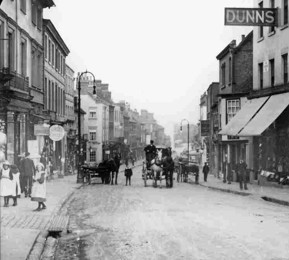When creating the Worksop Masterplan, we brought in the expert services of Planning and Development Consultant Timothy Crawshaw. In the fifth of a series of Blogs, he muses on how more homes in the town centre could reverse Worksop’s fortunes and make it an aspirational place to live.
Last week we looked at improving our housing through the refurbishment and improvement of existing buildings or exemplars of sustainable construction. These are important principles in the Worksop Town Centre Masterplan, however, over and above any improvements that reduce carbon dioxide emissions and the incidence of fuel poverty, the Town Centre as a location is inherently sustainable.
The Local Plan is seeking to accommodate around 700 homes in or close to the Town Centre, all of which will be sustainable in terms of location. With great access to the river and canal and the attractions of the Town Centre, these new homes will increase footfall and increase demand for local shops to serve these new residents.
The creation of walkable neighbourhoods will reduce trip demand and congestion and most of the population of the town will be within a 10-minute cycle ride. Living close to places of work, shops, leisure and services and public transport also reduces emissions from movement and promotes healthy travel choices such as walking and cycling. This vision of a sustainable and vibrant mixed-use Town Centre will establish Worksop as an aspirational place to live.
With an increase in footfall, shops and markets become more viable and local cafés and restaurants can serve both local needs and those of visitors. Also, a greater number of people living in the Town Centre improves community safety with more people occupying the streets in the evening going about their business and taking exercise.
There are significant opportunities to increase the use of the upper floors of buildings in the Town Centre. With an estimated 75 new homes that could be created out of underused space, the use of these upper floors secures the long-term future of these historic buildings.

Bridge Street Circa 1900 - Bridge Street Project
Historically many more people lived in the Town Centre before the suburban expansion of Worksop and the Masterplan seeks to re-establish this pattern. With a reduced reliance on out-of-town shopping and supermarkets in the future, local shops will be needed to serve the needs of the population. And, with increasing numbers of younger people choosing not to drive, a third of the under 25’s do not currently have a licence, the Town Centre may be an attractive option.
Whilst the recent Covid:19 crisis and lockdowns have potentially increased demand for out of town living temporarily, the sense of community, ease of access and sustainability benefits of town centre living are still compelling. However, there need to be some changes in terms of design, patterns of ownership and tenure if we are to attract a new generation of town centre residents. Affordability, security of tenure, access to outdoor space and housing quality are all considerations alongside the management and maintenance of buildings.
Timothy Crawshaw (MA MRTPI FRSA) is an International Planning and Development Consultant in the areas of urban design, planning, green infrastructure, energy efficiency and sustainable transport.
With experience in Eastern Europe, Africa and the Middle East, alongside an expanding UK practice, he has a specific interest in the role of the nature based approaches to addressing the climate emergency, alongside improving health and wellbeing outcomes and tackling inequality.
Timothy is an experienced lecturer, trainer and facilitator with a passion for community development, and he continues to champion the role of planning as a key part of the solution to the challenges of our times. Timothy is currently the Chair of the Tees Valley Nature Partnership and of the Historic Towns and Villages Forum and will be the Vice President of the Royal Town Planning Institute in 2021.
Last Updated on Wednesday, May 8, 2024